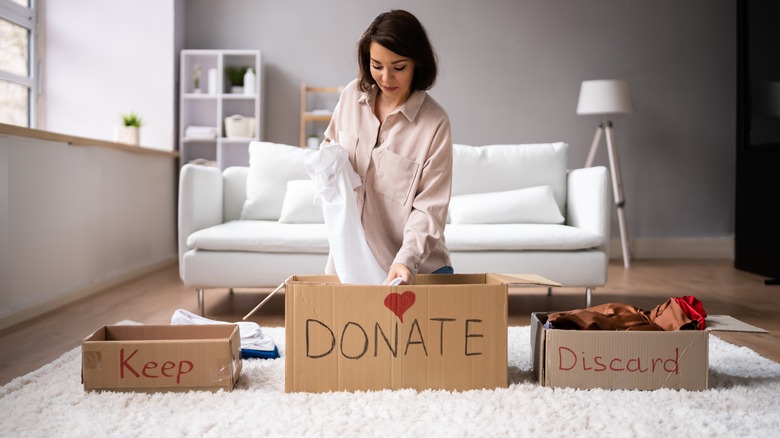What Is A 'Limbo Box' And How To Use It For Regret-Free Decluttering
Every so often, we get that itch to declutter and get rid of all the things lying around that we never use. Yet, when we sit down and go through our belongings, we find ourselves struggling to let many of them go. The Recovery Village notes that every 1 in 50 people is a classified hoarder, with 1 in 20 people affected by this habit. A hoarding disorder is simply the continuous trouble with disposing of items we don't need on the premise that someday we might — something we are all guilty of doing at one time or another.
The Wall Street Journal estimated that Americans spend $1.2 trillion a year on luxury and unnecessary items, from clothing and holiday décor to snacks and office supplies. Getting yourself in a good mindset and rhythm to dwindle the amount of stuff piled in your home will make a massive difference in your ability to donate what needs to be donated. And, once you start removing items from your house, it can bring more conscious purchasing to mind. One method to get you on your feet and detaching from things you don't use is through a 'limbo box.'
What is a 'limbo box?'
When going through our belongings, we usually dedicate things to one of two categories: to keep and to donate. But what if you created a third option? A limbo box is meant for any items that you cannot decide to hold onto or get rid of — a space between the decision to keep and donate something. You may wonder if you'll finally have an occasion where this dress feels right or if this decorative vase will finally be used. The items that cause thoughts of hesitation and what-ifs are perfect for a limbo box.
Once a limbo box is full, store it away in a closet out of sight and give yourself one to three months to determine if these items actually make a difference in your day-to-day life. If the answer is no, you can now peacefully dispose of that item without the impending thought that you might need it later. Feel free to allow yourself however much time you need to make this determination. Just remember that the point is to not hang onto unnecessary items, so giving yourself a timeline is critical. It is also essential to differentiate between valuable and sentimental items you keep versus objects that just lie around, taking up space.
Other methods for decluttering
According to the LA Times, the average U.S. home has 300,000 belongings. You can use many decluttering systems to increase motivation and make the task less overwhelming. Just as you can create a limbo box, you can create boxes for items you plan to fix, ones that need to be tossed, and others that need to be recycled. Not everything has to fit into one of two categories, and freeing that idea from your mind will make the process much easier. If you are holding onto something because you feel guilty about how much you spent on it, put it in a box for items that need to be sold rather than donated.
Start with smaller items like mugs that haven't seen the light of day in months or the junk drawers we have miscellaneously around our homes. Consider the snowball method of doing small bits at a time that will eventually add to a significant change. Giving yourself the goal of clearing out ten items a month will amount to 120 by the end of the year. Assign all your items to a designated home, and evaluate the necessity of any objects that don't have a place. Allowing yourself space and time with goals and checklists will make the undertaking of decluttering much more manageable.


